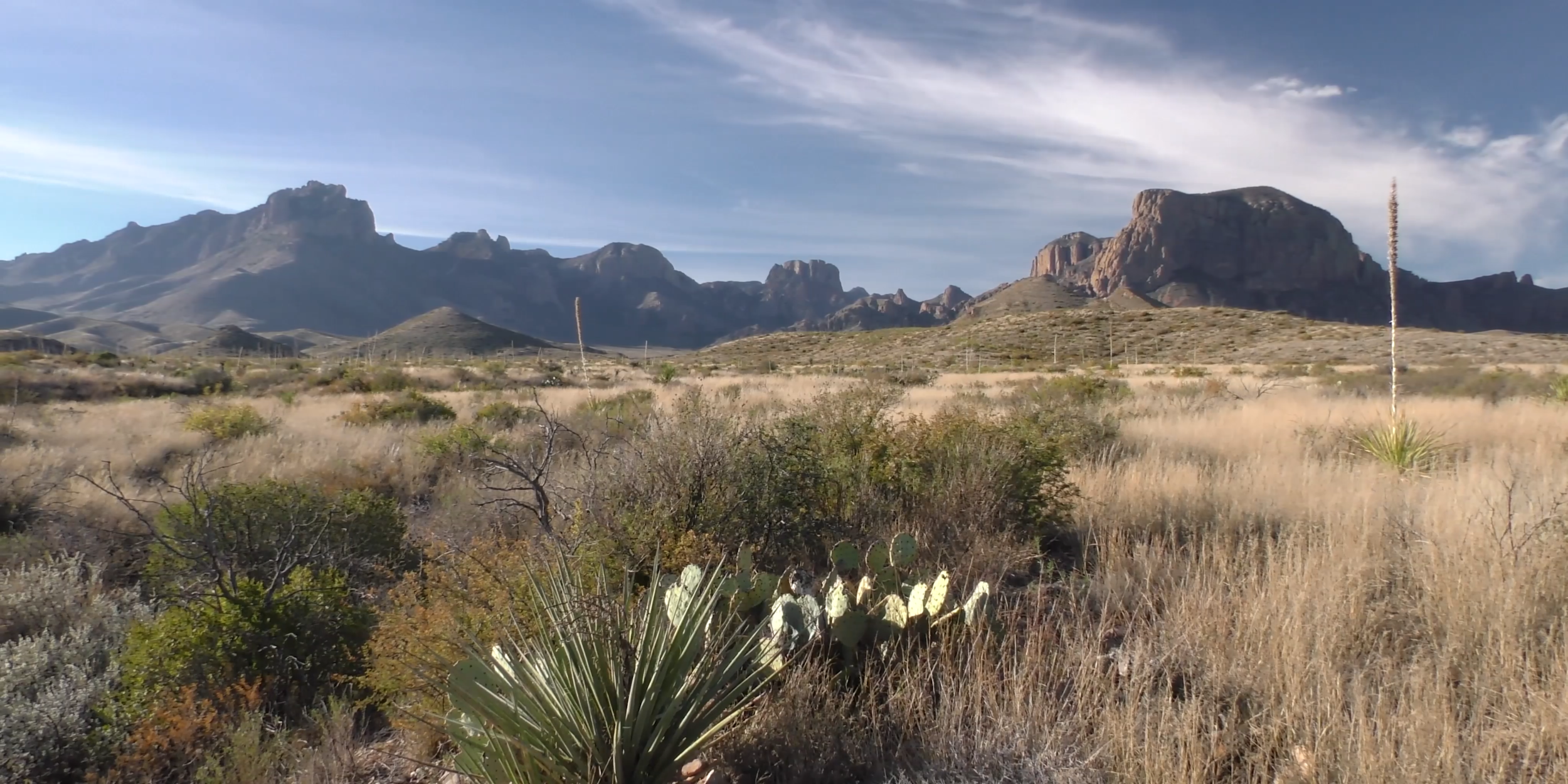
Development by Design in West Texas:
Mitigating Energy Sprawl Through Cooperative Landscape Planning
Kei Sochi, Jon Paul Pierre, Louis Harveson, Patricia Moody Harveson, David V. Iannelli,
John Karges, Billy Tarrant, Melinda Taylor, Michael H. Young and Joseph Kiesecker
May 2021
2. The Respect Big Bend Project & Study Area
The 18-county region of the Respect Big Bend project's study area in West Texas spans 28 million acres (113,190 km2) of nearly continuous Chihuahuan Desert scrub and grasslands. These desert types climb into the foothills of the Guadalupe, Davis and Chisos mountains, the United States and Texas portions of which are delineated by the Rio Grande along its western and southern borders. The region comprises an area larger than the state of Virginia and is one of the least densely populated regions in Texas, averaging less than 1 person per acre. Several of Texas’ largest parcels of public lands in the state can be found in the project area – among them Big Bend Ranch State Park (311,040 acres) and Big Bend National Park (801,280 acres). Emblems of a quintessentially western American landscape - cowboys, ranchers and explorers – still loom large here and belie the region’s central role on the global energy stage. It is within this layered story that the Respect Big Bend Coalition finds itself.
Figure 1. 18-county study area & the Tri-County Region.
The focus of this report is on the Tri-County Region of Jeff Davis, Brewster and Presidio counties. The report describes the natural resources and potential energy trajectories of the larger 18-county Trans-Pecos study area (Figure 1). Additionally, this report explores the ecology of the landscape, perspectives about future energy development and those valued landscape assets, identified by a Big Bend Region Stakeholder Advisory Group, with which the still-unfolding energy narrative will need reconciliation.
The Respect Big Bend Study Area
The bulk of the study area lies within the Chihuahuan Desert ecoregion. It reaches to parts of the southern High Plains ecoregion in the northeastern counties and the Edwards Plateau ecoregion to the southeast. The physiography of the region is extremely diverse. Elevations above mean sea level range from 900 feet at the confluence of the Pecos River and Rio Grande rivers to over 8,750 feet at Guadalupe Peak, the highest point in Texas. Topography varies from rugged peaks and sky islands to rolling hills to flat grasslands and desert shrublands. The region’s climate is typically semi-arid with annual precipitation averaging approximately 12 inches. The substantial differences in elevation and topography within the region contribute to high local variability of rainfall, fluctuating from an average of 9 to 27 inches annually. The entire region is prone to frequent and intense drought.
Significant variation in topography and rainfall across the 18-county study area also translates to diverse vegetation communities. Dominant plant communities shift from creosote bush and mesquite in the desert shrublands at lower elevations to mid-elevation grasslands and conifer woodlands at the highest elevations. Cottonwoods, desert willow and hackberry typically populate the riparian buffers.
From desert grasslands to cienegas to ponderosa pine forests, this region of deep West Texas supports more than 2,000 plant species, 500 bird species, 170 reptile and amphibian species and 120 mammal species. The native wildlife includes iconic grassland species such as pronghorn, kit fox and black-tailed prairie dog, kangaroo rats, burrowing owl and diverse birds-of-prey and several grassland bird species of known continental decline. Bat diversity in this study area is one of the highest in the state rivaling other places in the southwestern United States with as many as 18 recorded species. Arid-land reptile diversity is extraordinary, mostly among snakes and lizards, while also including rare aquatic turtles. Where permanent water occurs at springs, creeks and rivers, native fish species are numerous, often at risk, and several occur nowhere else. Regional bird diversity is rich in this mixing zone of two continental migratory flyways, and large native mammals like black bears, mule deer and desert bighorn sheep live in isolated sky island mountain ranges and cross lowlands and foothills while moving between mountain ranges.
Perceptions of Energy Development in the Big Bend Region
In the fall of 2017, the Cynthia and George Mitchell Foundation commissioned public opinion research on statewide and local perspectives about energy development in the Respect Big Bend region. This was done in two phases with focus groups and telephone surveys (for additional details and results, see supplement S1. Public Opinion Research Findings).
Attitudes about energy development and how it plays out in a landscape were consistent across the groups. These attitudes included:
A majority of Texans think energy development is good for the state, but, like Far West Texas residents, they do not want it to take place just anywhere. When asked to choose, most Texans prioritized protecting communities and land and water resources for future generations over energy development.
People are skeptical that energy can be produced without harming communities and natural resources.
Eighty-one percent of Texans believe that cities and towns should have greater input when energy development is likely to have an impact on their own communities and quality of life.
Avoiding the worst impacts from energy development on their communities will require better planning that includes meaningful and substantive participation directly from community members. However, there is a general feeling that communities are brought in too late in the process, when important decisions have already been made.
In addition to having a greater say in what happens in their communities, residents favor a wide variety of proposals to manage potential impacts. Among these proposals are increased reporting requirements on water contamination and stronger mitigation standards that anticipate and prevent negative impacts, while also requiring restoration of impacted lands to their original state.
The Development by Design approach is meant to address these core concerns by bringing together the right mix of people or actors – from the energy industry, elected officials, land managers, conservationists, scientists and community members – to take into account the needs and priorities of all stakeholders at the earliest stages of land use and development decision-making.
The Stakeholder Advisory Group
RBB convened experts and stakeholders from the Tri-County Region (i.e., Brewster, Jeff Davis and Presidio counties) to serve on a Stakeholder Advisory Group (SAG) to identify priorities in the region. Members of the SAG include land and mineral rights owners, local government officials, conservationists and community members – all have deep knowledge of the area, local laws and policies and a view on the feasibility of different conservation and restoration strategies. The Respect Big Bend Coalition and SAG also received input from oil and gas and renewable energy representatives, Texan by Nature and conservation organizations. For a full list of SAG members, please see supplement section S2. Stakeholder Engagement Process.
Over the course of two years starting in 2019, the SAG met 13 times and identified seven values that are the foundation of a shared conservation vision for the Tri-County Region. They provided valuable guidance to efforts to map these values, review energy projections and delineate solutions to encourage development that would avoid or minimize impacts to conservation values.
The SAG focused on values that were important for their local counties. Although we mapped these values across the larger 18-county study area to put these values in context, we acknowledge that a comprehensive list of focal values for this larger region would require additional outreach with stakeholders outside of the Tri-County Region. These seven Tri-County-centered values are:
Ranching heritage and private property rights
Sky islands, water resources and grasslands
Wildlife and migratory corridors
Tourism and hunting
Viewsheds and vistas, dark skies, remoteness and quietude
Community, safety, and quality of life
Culture, music and the arts


